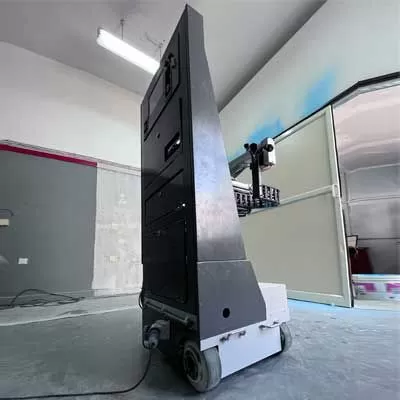- Home
- Technology
- Purpose-Built Construction

Purpose-Built Construction
Several construction projects in India face the acute challenge of completing work within stipulated timelines and budgeted costs.
Most often, changes occur during construction till quite late in the construction lifecycle because of various reasons like government policies, FSI approvals or design modifications, resulting in delays and cost overruns. However, 4D and 5D BIM technologies come to the rescue in such cases and facilitate timely completion of projects within cost estimates. Trimble offers the world's first purpose-built construction software, Vico Office, which allows users to 'plug in' the BIM authoring application of their choice and perform a constructability analysis, quantity takeoff, a model-based schedule, model-based estimate, and on-site production control, all in an integrated workflow. Such an integrated workflow is unique in the construction market, as Rajan Aiyer, Managing Director, Trimble SAARC region, shares. 'Trimble offers a living model - a model where the 3D geometry is integrated with the quantities, project schedule (4D), and estimate (5D).' This unique capability allows changes to be managed efficiently and accurately, ensuring timely completion of projects within cost estimates. Aiyer shares more on the software, why and how it is a boon for the construction industry, with CW.
Virtual Construction - an effective solution to building industry's challenges
Virtual Construction brings in a great change to the building industry. Now the industry has a tool to predict what is going to happen on a construction project with much greater accuracy than it had before. The 5D BIM workflow starts at the creation of a new project and ends with reporting and data mining. Vico's 5D Virtual Construction solutions pioneered the category of BIM for construction, and offers the industry an integrated approach to coordination, quantity takeoff, cost estimation, project scheduling, and production control. The benefits of the solutions and services have been proven on hundreds of building projects to date globally.
Vico provides multiple modules, grouped for the benefit of different project
stakeholders in a construction lifecycle: 2D-3D change management: Vico Document Controller compares 2D drawing set versions and 3D model versions to identify changes, deletions and additions.
3D BIM for visualisation: Vico Office works with popular BIM authoring tools such as Graphisoft ArchiCAD, Autodesk Revit and Tekla Structures. It also includes additional importers for SketchUp, CAD Duct, 3D DWG and IFC files.
3D BIM for clash detection: Vico Constructability Manager provides an integrated solution for clash detection and coordination resolution to identify constructability issues in the planning stage.
3D BIM for layout: Vico Layout Manager maps critical points in the virtual model to corresponding physical points on the jobsite, speeding up installation and eliminating costly rework.
3D BIM for quantity takeoff: Vico Takeoff Manager derives construction-calibre quantities by location from BIM models for more accurate schedules and estimates. 4D BIM for scheduling and production control: Vico LBS Manager is an organised approach to dividing the project into work locations. Locations defined in LBS Manager also yield quantities by location for use in scheduling and procurement. Also, Vico Schedule Planner creates construction schedules by using BIM model elements and associating them with tasks and the corresponding materials, resources and labour. Plus, Vico Production Controller is used in the build phase; near real-time production updates from the site enable forward-looking schedule forecasts. And, Vico 4D Manager is a 4D simulation presentation tool that provides rich 3D visualisation of the project timeline to the extended construction team.
5D BIM for estimating: Based on the concept of target cost planning, Vico Cost Planner provides an evolving cost estimate that readily compares one version to another and any version to the original target cost plan. Also, Vico Cost Explorer is the first model-based budgeting application that allows the extended project team to visually understand which aspects of the project are contributing to changes in cost. Construction management reporting: Vico Office Client is the cornerstone of the Vico Office Suite. Here, model versions are managed, information is shared across the team, and an inline reporting engine pulls information from all departments to deliver construct ability reports, cost and resource-loaded schedules, proposed design changes, cost estimates, cash flow reports, and other customisable reports.
Used for much more than visualisation, Vico Office extends the basic 3D model with constructability analysis and coordination, quantity takeoff, 4D location-based scheduling and production control, and 5D estimating. It helps the construction industry realise greater agility, efficiency and insight, thus helping it achieve transformative results.
Integrating data together
Technology follows construction workflows and brings in a culture of discipline, transparency and collaboration within construction projects. Once the design is completed using 3D models, technology allows various stakeholders to produce estimates of cost and time. As the Trimble platform is completely integrated and data is common for all functions, whether it is design, estimation or scheduling, organisations need not use point solutions to bring data from one application to another, since this can cause loss of data and improper integration, which in turn would lead to delays and cost overruns.
Cost and time overruns
By using common data on the integrated 4D/5D BIM platform, organisations can have better control on changes, which will offer better control on cost and time schedules. With the help of 4D technology, organisations can ensure that there is minimum time gap between two activities and workers do not sit idle between activities. 4D also alerts and advises how much progress should have happened on any day on an activity in a given project; if there is a delay, it can suggest corrective steps to be taken to bring the project activity on track.
Using 5D technologies, cost plans can be prepared using 3D models as inputs and one can compare them with targeted costs to take corrective action wherever needed. Additionally, at the end of the project, the construction company has a rich, fully constructible 5D model, which can be used during the O&M phase as well as for future enhancements, modifications, etc. Such models can also be used for more accurate bidding in future projects.
Project application
Any medium to large construction project, be it high-rise and/or infrastructure project such as rail or metro station or airport, must adopt this building technology. As the Indian economy continues to expand, investment in infrastructure and housing will ensure that latest building technologies are applied in the projects. Some organisations have a misconception that once a 3D model is made, they have realised BIM. However, BIM is not a product or software but a process that encompasses the entire construction workflow. The industry is becoming aware of this very quickly and has started to leverage building technologies much more than before and we are confident that the pace will only quicken from here on.
Challenges in adoption
As is the case with any change, organisations will need to initiate the reengineering of certain business processes to fully utilise the potential of this technology. In most construction-focused organisations, various departments such as design, cost estimation and time scheduling tend to work in silos, not often using common data. They need to move to 3D and take the full benefit of the model, instead of just using the model as a visualisation tool.
Today, there are vanguard organisations and a few who adopt international best practices but India deserves the benefits of construction technologies on a much wider scale, which in turn will help the industry and the end-users. These solutions are quite affordable, and with the subscription model the affordability quotient of the 4D and 5D solutions is even better now, which would further facilitate adoption. We would like to emphasise that the project cost and time benefits so outweigh the investment that adoption is a 'no-brainer'.
Share your views on this article at feedback@ConstructionWorld.in
Trimble's VICO Office allows users to 'plug in' the BIM authoring application of their choice and perform a constructability analysis, change management, cost and time estimation, all in an integrated workflow. Several construction projects in India face the acute challenge of completing work within stipulated timelines and budgeted costs. Most often, changes occur during construction till quite late in the construction lifecycle because of various reasons like government policies, FSI approvals or design modifications, resulting in delays and cost overruns. However, 4D and 5D BIM technologies come to the rescue in such cases and facilitate timely completion of projects within cost estimates. Trimble offers the world's first purpose-built construction software, Vico Office, which allows users to 'plug in' the BIM authoring application of their choice and perform a constructability analysis, quantity takeoff, a model-based schedule, model-based estimate, and on-site production control, all in an integrated workflow. Such an integrated workflow is unique in the construction market, as Rajan Aiyer, Managing Director, Trimble SAARC region, shares. 'Trimble offers a living model - a model where the 3D geometry is integrated with the quantities, project schedule (4D), and estimate (5D).' This unique capability allows changes to be managed efficiently and accurately, ensuring timely completion of projects within cost estimates. Aiyer shares more on the software, why and how it is a boon for the construction industry, with CW. Virtual Construction - an effective solution to building industry's challenges Virtual Construction brings in a great change to the building industry. Now the industry has a tool to predict what is going to happen on a construction project with much greater accuracy than it had before. The 5D BIM workflow starts at the creation of a new project and ends with reporting and data mining. Vico's 5D Virtual Construction solutions pioneered the category of BIM for construction, and offers the industry an integrated approach to coordination, quantity takeoff, cost estimation, project scheduling, and production control. The benefits of the solutions and services have been proven on hundreds of building projects to date globally. Vico provides multiple modules, grouped for the benefit of different project stakeholders in a construction lifecycle: 2D-3D change management: Vico Document Controller compares 2D drawing set versions and 3D model versions to identify changes, deletions and additions. 3D BIM for visualisation: Vico Office works with popular BIM authoring tools such as Graphisoft ArchiCAD, Autodesk Revit and Tekla Structures. It also includes additional importers for SketchUp, CAD Duct, 3D DWG and IFC files. 3D BIM for clash detection: Vico Constructability Manager provides an integrated solution for clash detection and coordination resolution to identify constructability issues in the planning stage. 3D BIM for layout: Vico Layout Manager maps critical points in the virtual model to corresponding physical points on the jobsite, speeding up installation and eliminating costly rework. 3D BIM for quantity takeoff: Vico Takeoff Manager derives construction-calibre quantities by location from BIM models for more accurate schedules and estimates. 4D BIM for scheduling and production control: Vico LBS Manager is an organised approach to dividing the project into work locations. Locations defined in LBS Manager also yield quantities by location for use in scheduling and procurement. Also, Vico Schedule Planner creates construction schedules by using BIM model elements and associating them with tasks and the corresponding materials, resources and labour. Plus, Vico Production Controller is used in the build phase; near real-time production updates from the site enable forward-looking schedule forecasts. And, Vico 4D Manager is a 4D simulation presentation tool that provides rich 3D visualisation of the project timeline to the extended construction team. 5D BIM for estimating: Based on the concept of target cost planning, Vico Cost Planner provides an evolving cost estimate that readily compares one version to another and any version to the original target cost plan. Also, Vico Cost Explorer is the first model-based budgeting application that allows the extended project team to visually understand which aspects of the project are contributing to changes in cost. Construction management reporting: Vico Office Client is the cornerstone of the Vico Office Suite. Here, model versions are managed, information is shared across the team, and an inline reporting engine pulls information from all departments to deliver construct ability reports, cost and resource-loaded schedules, proposed design changes, cost estimates, cash flow reports, and other customisable reports. Used for much more than visualisation, Vico Office extends the basic 3D model with constructability analysis and coordination, quantity takeoff, 4D location-based scheduling and production control, and 5D estimating. It helps the construction industry realise greater agility, efficiency and insight, thus helping it achieve transformative results. Integrating data together Technology follows construction workflows and brings in a culture of discipline, transparency and collaboration within construction projects. Once the design is completed using 3D models, technology allows various stakeholders to produce estimates of cost and time. As the Trimble platform is completely integrated and data is common for all functions, whether it is design, estimation or scheduling, organisations need not use point solutions to bring data from one application to another, since this can cause loss of data and improper integration, which in turn would lead to delays and cost overruns. Cost and time overruns By using common data on the integrated 4D/5D BIM platform, organisations can have better control on changes, which will offer better control on cost and time schedules. With the help of 4D technology, organisations can ensure that there is minimum time gap between two activities and workers do not sit idle between activities. 4D also alerts and advises how much progress should have happened on any day on an activity in a given project; if there is a delay, it can suggest corrective steps to be taken to bring the project activity on track. Using 5D technologies, cost plans can be prepared using 3D models as inputs and one can compare them with targeted costs to take corrective action wherever needed. Additionally, at the end of the project, the construction company has a rich, fully constructible 5D model, which can be used during the O&M phase as well as for future enhancements, modifications, etc. Such models can also be used for more accurate bidding in future projects. Project application Any medium to large construction project, be it high-rise and/or infrastructure project such as rail or metro station or airport, must adopt this building technology. As the Indian economy continues to expand, investment in infrastructure and housing will ensure that latest building technologies are applied in the projects. Some organisations have a misconception that once a 3D model is made, they have realised BIM. However, BIM is not a product or software but a process that encompasses the entire construction workflow. The industry is becoming aware of this very quickly and has started to leverage building technologies much more than before and we are confident that the pace will only quicken from here on. Challenges in adoption As is the case with any change, organisations will need to initiate the reengineering of certain business processes to fully utilise the potential of this technology. In most construction-focused organisations, various departments such as design, cost estimation and time scheduling tend to work in silos, not often using common data. They need to move to 3D and take the full benefit of the model, instead of just using the model as a visualisation tool. Today, there are vanguard organisations and a few who adopt international best practices but India deserves the benefits of construction technologies on a much wider scale, which in turn will help the industry and the end-users. These solutions are quite affordable, and with the subscription model the affordability quotient of the 4D and 5D solutions is even better now, which would further facilitate adoption. We would like to emphasise that the project cost and time benefits so outweigh the investment that adoption is a 'no-brainer'. Share your views on this article at feedback@ConstructionWorld.in




















